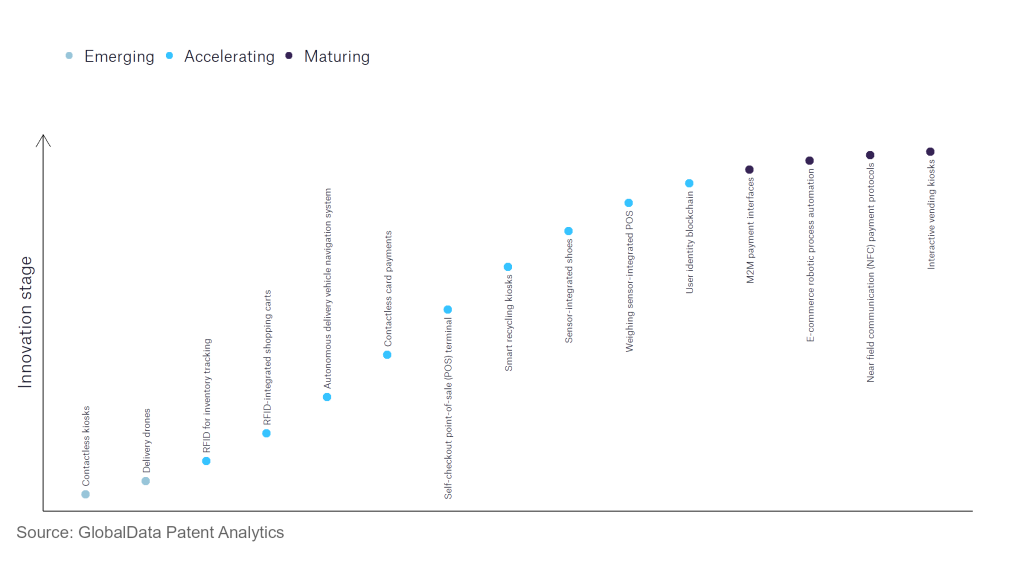The retail industry continues to be a hotbed of innovation, with activity driven by technology, environmental sustainability, regulatory reforms, and risk mitigation, and the growing importance of technologies such as customer service robotics, robotic inventory management, voice commerce, and smart checkout. In the last three years alone, there have been over 133,000 patents filed and granted in the retail industry, according to GlobalData’s report on Autonomous delivery vehicle navigation system. Buy the report here.
However, not all innovations are equal and nor do they follow a constant upward trend. Instead, their evolution takes the form of an S-shaped curve that reflects their typical lifecycle from early emergence to accelerating adoption, before finally stabilising and reaching maturity.
Identifying where a particular innovation is on this journey, especially those that are in the emerging and accelerating stages, is essential for understanding their current level of adoption and the likely future trajectory and impact they will have.
70+ innovations will shape the retail industry
According to GlobalData’s Technology Foresights, which plots the S-curve for the retail industry using innovation intensity models built on over 128,000 patents, there are 70+ innovation areas that will shape the future of the industry.
Within the emerging innovation stage, contactless kiosks and delivery drones are disruptive technologies that are in the early stages of application and should be tracked closely. RFID for inventory tracking, autonomous delivery vehicle navigation system, and contactless card payments are some of the accelerating innovation areas, where adoption has been steadily increasing. Among maturing innovation areas are M2M payment interfaces and e-commerce robotic process automation, which are now well established in the industry.
Innovation S-curve for Internet of Things in the retail industry

Autonomous delivery vehicle navigation system is a key innovation area in Internet of Things
An autonomous delivery vehicle navigation system works with the help of a global positioning system (GPS). Several GPS satellites provide real-time geographical data to determine the latitude, longitude, speed, and course for the delivery vehicle to navigate.
GlobalData’s analysis also uncovers the companies at the forefront of each innovation area and assesses the potential reach and impact of their patenting activity across different applications and geographies. According to GlobalData, there are 20+ companies, spanning technology vendors, established retail companies, and up-and-coming start-ups engaged in the development and application of autonomous delivery vehicle navigation system.
Key players in autonomous delivery vehicle navigation system – a disruptive innovation in the retail industry
‘Application diversity’ measures the number of different applications identified for each relevant patent and broadly splits companies into either ‘niche’ or ‘diversified’ innovators.
‘Geographic reach’ refers to the number of different countries each relevant patent is registered in and reflects the breadth of geographic application intended, ranging from ‘global’ to ‘local’.
Patent volumes related to autonomous delivery vehicle navigation system
Source: GlobalData Patent Analytics
Gogoro is one of the leading patent filers in the field of autonomous delivery vehicle navigation system. Some other key patent filers in the autonomous delivery vehicle navigation system space include Cox Enterprises, Nuro, and Didi Global. Recently, Gogoro launched its Smartscooters and battery-swapping technology in Israel. After its initial launch in Tel Aviv, the company plans to expand to other Israeli cities as well.
In terms of application diversity, Gogoro leads the pack, while Cox Enterprises and Nielsen stood in the second and third positions, respectively. By means of geographic reach, Baidu held the top position, followed by Dentsu Group and Didi Global.
Autonomous delivery vehicle navigation system will potentially become an important aspect in the retail industry. With retail companies increasingly focusing on automation, autonomous delivery vehicle navigation system will gain popularity.
To further understand the key themes and technologies disrupting the retail industry, access GlobalData’s latest thematic research report on Internet of Things (IoT) in Retail and Apparel.
Data Insights
From

The gold standard of business intelligence.
Blending expert knowledge with cutting-edge technology, GlobalData’s unrivalled proprietary data will enable you to decode what’s happening in your market. You can make better informed decisions and gain a future-proof advantage over your competitors.



